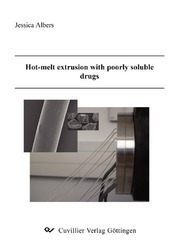| Fachbereiche | |
|---|---|
| Buchreihen (96) |
1378
|
| Nachhaltigkeit |
3
|
| Gesundheitswesen |
1
|
| Geisteswissenschaften |
2363
|
| Medienwissenschaften | 16 |
| Theologie | 57 |
| Philosophie | 102 |
| Rechtswissenschaft | 422 |
| Wirtschaftswissenschaften | 850 |
| Sozialwissenschaften | 416 |
| Sportwissenschaften | 48 |
| Psychologie | 233 |
| Pädagogik | 190 |
| Geschichtswissenschaften | 182 |
| Kunstwissenschaften | 110 |
| Kulturwissenschaften | 166 |
| Literaturwissenschaften | 116 |
| Sprachwissenschaften | 88 |
| Naturwissenschaften |
5406
|
| Ingenieurwissenschaften |
1791
|
| Allgemein |
98
|
|
Leitlinien Unfallchirurgie
5. Auflage bestellen |
|
Erweiterte Suche
Hot-melt extrusion with poorly soluble drugs
Jessica Albers (Autor)Vorschau
Inhaltsverzeichnis, Datei (42 KB)
Leseprobe, Datei (100 KB)
Hot-melt extrusion with poorly soluble drugs is a challenging method to enhance the solubility. The formation of solid dispersions, specifically of glassy solid solutions, wherein the drug is dispersed on a molecular basis in an inert carrier, leads to metastable systems that have advantageous dissolution behaviour but suffer from physical stability problems. To date, there is poor understanding of the solid state structure, the mechanism by which dissolution enhancement occurs, the stability on storage and in dissolution, and the processing to solid dosage forms.
The hot-melt extrusion process is influenced by several parameters. The right coordination of these parameters is decisive for the production of solid dispersions and thus, the success in solubility enhancement. The solid state and the viscosity of the extrudates can be controlled by the temperature of the barrels. Besides the configuration of the screw and the temperature profile of the barrel, the design of the die plate represents the third important extrusion parameter. By keeping the dead storage capacity at a minimum, an early solidification and thus a blockage of the dies can be prevented. Due to shear forces evolving in the extruder barrel and the ability of the drug to dissolve in the molten carrier before reaching the melting temperature, the process temperature can be kept below the melting point of the substances. Basic butylated methacrylate copolymer is a suitable carrier to enhance the solubility of the poorly water-soluble drug celecoxib in a hot-melt extrusion process. The best solubility enhancement can be obtained by dispersing the drug in the molten carrier on a molecular basis and thus, to form glassy solid solutions. The solid state characteristics of the solid dispersion can be revealed by DSC analysis and interpretation of the corresponding glass transitions.
Such systems may contain a drug load of up to 60% and are stable at increased temperature and humidity which is due to the very low water uptake of the components. Glassy solid solutions of celecoxib and basic butylated methacrylate copolymer have a fast dissolution rate and result in a 58 fold supersaturated solution. The mechanism of drug release from these glassy solid solutions is carrier-controlled and governed by dissolution. The enhancement of the dissolution rate is based on improved solubility and wettability. Basic butylated methacrylate copolymer interacts chemically with celecoxib in an acid-base reaction. The hot-melt extrusion process is highly dependent on the physicochemical properties of the compounds and their miscibility in the molten state. The use of basic butylated methacrylate copolymer as solubility enhancing carrier in hot-melt extrusion cannot be transferred easily to all drugs. Depending on the properties of the drug, specifically the melting point and the pKa, basic butylated methacrylate copolymer can be a useful carrier in glassy solid solution formation, but might be insufficient for solubility improvement. The formation of a glassy solid solution evolves from interactions between the drug and the carrier. Bonds can differ in their strength and can be advantageous or disadvantageous for a fast dissolution. Furthermore, decomposition processes can occur, when processing the drug at high temperatures. Thus, each formulation has to be analyzed separately.
The interpretation of the chemical structure, the calculation of solubility parameters, the determination of melting temperatures and enthalpies, and the performance of molecular dynamics simulations are tools to predict the miscibility of drugs and carriers for the formulation of solid dispersions. A combined approach of tools predicting miscibility is highly appropriate, as no single technique may yield all the required information. Nevertheless, the evaluation of the melting behaviour via DSC has the highest impact. Hot-melt extruded glassy solid solutions can be processed into solid dosage forms. The mechanical energy input through milling and zabletting has no influence on the solid-state stability. The solution-state stability can be achieved by adding HPMC to the external phase. The filling of capsules with milled hot-melt extrudates is a promising technique to obtain solid dosage forms from glassy solid solutions. By the extensive analysis of the hot-melt extrusion process, the interactions of the compounds, the thermal characteristics, and the dissolution mechanism of the resulting systems, it is possible to predict the extrusion process in an early stage of development and to improve the dissolution of poorly soluble drugs.
| ISBN-13 (Printausgabe) | 3867276978 |
| ISBN-13 (Printausgabe) | 9783867276979 |
| ISBN-13 (E-Book) | 9783736926974 |
| Buchendformat | A5 |
| Sprache | Englisch |
| Seitenanzahl | 156 |
| Auflage | 1 Aufl. |
| Band | 0 |
| Erscheinungsort | Göttingen |
| Promotionsort | Universität Düsseldorf |
| Erscheinungsdatum | 22.08.2008 |
| Allgemeine Einordnung | Dissertation |
| Fachbereiche |
Philosophie
|








